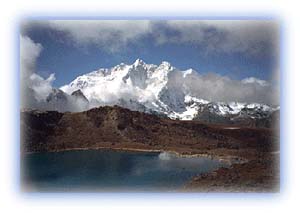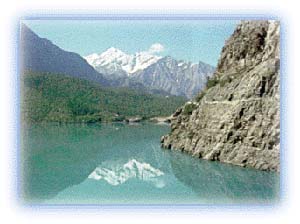Nepal Himalayas
General Info
· Solo Khumbu
· Namche Bazar
· Thyangboche
· Pangboche
· Kalapattar
· Pheriche
· Buddhism in Khumbu
· People: Sherpas
· Mount Everest
· The Quest for Everest
· Early Years
· The 1950s
· Sherpas on Everest
· Central Nepal
· Mustang
· Jomsom
· People: Thakalis
· Muktinath
· Manang valley
· Bryagu village
· Manang village
· Nyasang Division
· Western Nepal
· Jumla
· Sukhadik
Photo Feature:
· Annapurna region
High Altitude Sickness
Endangered Species
Protected Areas
· Royal Chitwan National Park
· Royal Bardiya National Park
· Mt. Everest National Park
· Langtang National Park
· Rara National Park
Shey Phoksundo National Park
Khaptad National Park
· Koshi Tapu Wildlife Reserve
· Parsa Wildlife Reserve
· Royal Sukla Phant Wildlife Reserve
· Dhorpatan Hunting Reserve
· Annapurna Area Conservation Project
Yaks
The Yeti Factor

![]()
|
Makalu-Barun National Park and Conservation Area This national park lies in the wilderness at the eastern border of Mount Everest National Park and is more remote. This park also borders with another park on the Tibetan side called Qomolangma Nature reserve. Qomolangma is the Tibetan name for Mt Everest. This park is the latest one established in Nepal and is still in the development stage. Its altitude ranges from 1,000 m to more than 8,000 m. This park contains four of the five highest mountains in the world. Most of the northern part of this park includes dense forests, valleys of the Barun River, great waterfalls and deep gorges. |
 |
| Looking across the Kangshung Valley towards the Himalayan giants Makalu and Chomolonzo Credit: W. Spiegelman |
This park is ideal for people who love natural wilderness. It is the most amazing and prolific area from the botanical viewpoint because it contains more than 3,000 flowering plants. Also about 67 species of medicinal plants and aromatic plants are to be found here. This park is the home of more than 50 species of animals and 400 species of birds. Red panda, musk deer, Himalayan thar, barking deer black bear, wild boar are some of the species found here.
Shey Phoksundo National Park
This is the largest national park in Nepal and stretches over
the Trans Himalayan region. Therefore this park represents a
whole range of climates that are found in Nepal. This is the
only park in Nepal where the Tibetan desert type of fauna and
flora are found.
 |
| Phoksundo Lake Credit: Mahabir Pun |
The main attractions of this park are the Phoksundo Lake and the Shey Monastery. Because of its remoteness, very few tourists visit this national park. Suligad (543 ft, 167 m), the water fall at the highest elevation in the world, comes from Phoksundo Lake at 11,855 ft (3,647 m). This region has been affected very little by modernization.
The wild animals that are found here are Tibetan hare, Himalayan weasels, Himalayan black and brown bear, blue sheep, wild yak, Tibetan antelope, wild yak and different varieties of pheasants.
Khaptad National Park
This park is situated in the far western mountains of Nepal.
This national park is different from other national parks in
its origin. This was set aside as a national park mainly for
religious purposes. A Hindu guru called Khaptad Swami -- also a
naturalist -- has been living in this secluded area for many
years. It was because of his efforts that an area of about 225
square kilometers (89 square miles) was set aside as a national
park. Most of the park has been designated as a sacred forest.
This park mainly consists of rolling hills covered with pastures and oak and coniferous forests. The Hindu guru, who speaks fluent English, is the unofficial caretaker of this park.
All rights reserved